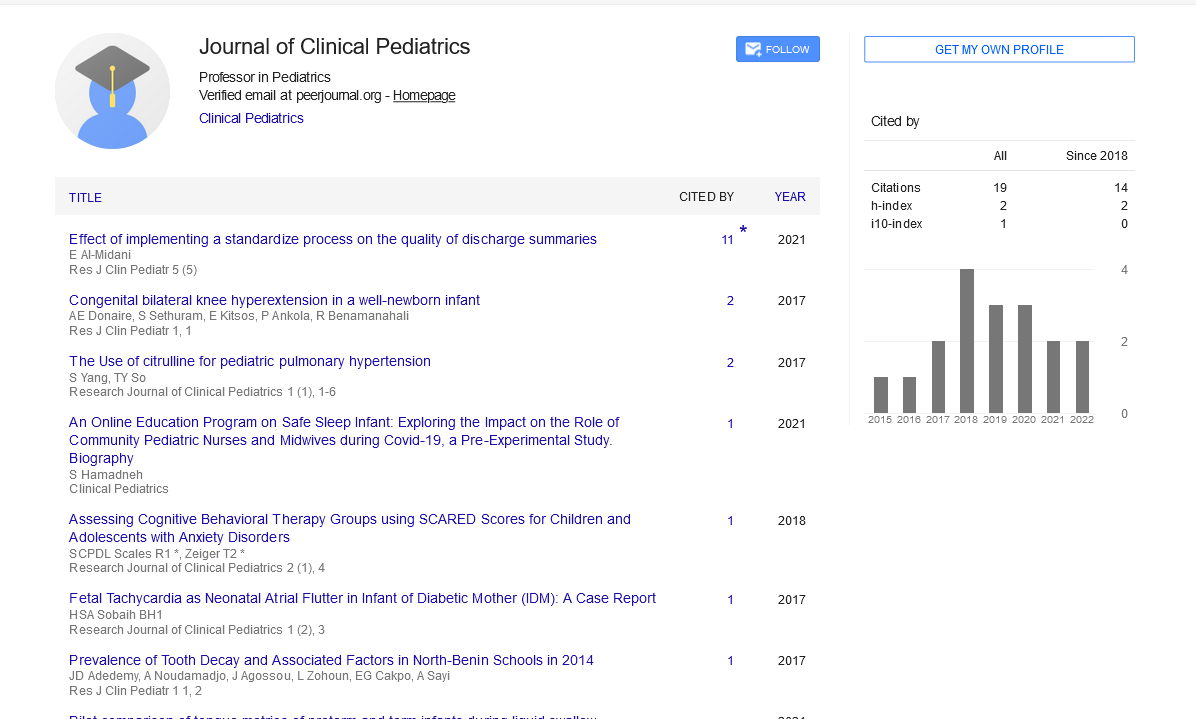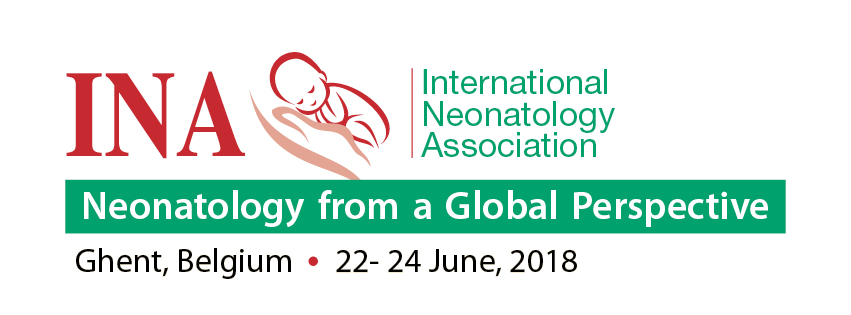Perspective, Res J Clin Pediatr Vol: 6 Issue: 2
Incidence of Neonatal Sepsis and its Risk Factors during Perinatal Time
Leen Jamel Doya*
Department of Pediatrics, Faculty of Medicine, Tishreen University Hospital, Latakia, Syria
*Corresponding Author: Leen Jamel Doya
Department of Pediatrics, Faculty of Medicine, Tishreen University Hospital,Latakia, Syria
Email: jameleendoya@yahoo.com
Received date: 01 March, 2022, Manuscript No. RJCP-22-59753;
Editor assigned date: 03 March, 2022, PreQC No. RJCP-22-59753(PQ);
Reviewed date: 14 March, 2022, QC No RJCP-22-59753;
Revised date: 25 March, 2022, Manuscript No. RJCP-22-59753(R);
Published date: 01 April, 2022, DOI: 10.4712/rjcp.1000123.
Citation: Doya LJ (2022) Incidence of Neonatal Sepsis and its Risk Factors during Perinatal Time. Res J Clin Pediatr 6:2.
Keywords: Neonatal Sepsis
Introduction
Infant sepsis is a major cause of neonatal morbidity and mortality, and it is a persistent global public health problem, especially in underdeveloped countries. The goal of the study is to find out how common early neonatal infections are, as well as the risk factors connected with neonatal intensive care. Blood samples were drawn for laboratory analysis (CBC, CRP) with a blood culture in a crosssectional study that included all newborns admitted to Tishreen University Hospital's neonatal intensive care unit from October 2019 for one year and who met clinical and laboratory criteria for early neonatal sepsis. Early neonatal sepsis affected 197 neonates (28.14%). Blood cultures were negative in the vast majority of patients (80.71%). Staphylococcus albicans, Streptococci, and E. coli were the most prevalent pathogens in early newborn infections. Cesarean section was found to be the most common risk factor for early neonatal infection, followed by maternal infections, male newborn sex, low birth weight, prematurity, maternal age greater than 30 years and less than 20 years, early rupture of membranes, need for resuscitation, and meconium amino fluid, according to the current study. The current study found a high frequency of early neonatal sepsis in Tishreen University Hospital, and it was linked to a number of risk variables, the most common of which were caesarean section, male newborn gender, low birth weight, and prematurity.
Neonatal Septicemia Affects in Live Births
The entrance of infections, their toxins, or their antigens into the blood circulation during the first 72 hours of life causes early newborn septicemia, a clinical laboratory condition. Non-specific manifestations are used to make the diagnosis (low or high temperature of the newborn, lethargy, irritability, tachypnea or episodes of apnea, rapid or weak pulse, hypotension, low or high blood sugar, metabolic acidosis).
Neonatal septicemia affects 1.6% of all live births in poor nations. The most common condition in the newborn stage is early and late neonatal septicemia, which causes a high rate of morbidity and mortality. According to WHO estimates, it is responsible for 30%-50% of newborn fatalities in underdeveloped nations. Early neonatal sepsis is caused by microorganisms that are delivered through the placenta, during labor, or after childbirth. It could be a bacterial, viral, or fungal infection. The most prevalent pathogen that causes early newborn sepsis is Streptococcus (group B), which is followed by Coli (30%), Listeria, Hemophilic influenza, Enterococci, Staphylococci and Pneumococci.
There are numerous risk factors for early neonatal sepsis, including maternal factors (urinary and genital infections, prenatal fever, prenatal laboratory septicemia, multiple pregnancies, frequent vaginal examinations, premature rupture of membranes lasting more than 18 hours), neonatal factors (prematurity, low birth weight, perinatal asphyxia, low apgar scores, intrauterine infection), and environmental factors (prematurity, low birth weight, perinatal ashy (use of resuscitation tools, medical and nursing staff). The laboratory criteria for early newborn sepsis include White Blood Cells (WBC), neutrophil count, C Reactive Protein (CRP), and Platelet Count (PLT). The gold standard in diagnosis is a blood culture. Despite significant advancements in neonatal therapy, high death rates (30%-50%) in developing countries remain a concern when compared to developed ones. We did this investigation since no local study has evaluated the prevalence of risk factors for early newborn sepsis in Syria; therefore we were able to identify the most common risk factors for sepsis.
Advancements in Neonatal Therapy
Tishreen University Hospital's ethical committee examined and approved the current study. The patient's parents gave their informed consent. Between October 2019 and November 2020, 197 newborns were referred to Tishreen University Hospital in Lattakia for neonatal intensive care in an observational descriptive research. On admission, detailed information was recorded on the research form (age, sex, gestational age, birth weight, age at admission, type of delivery, type of pregnancy, use of assistive devices, premature rupture of membranes, maternal age, urinary and genital infections in the mother, maternal age, laboratory evaluation of the mother, amniotic fluid, obstetric apgar, need for postpartum resuscitation, presence of congenital anomalies) along with a full clinical examination of WBC, CRP, and PLT were measured in the laboratory of Tishreen University Hospital, along with a blood culture technique. The current study included 197 neonates (28.41%) who were referred to neonatal intensive care at Tishreen. The majority of blood cultures in the current study were negative (80%), which could indicate that the majority of the women in the sample had received prenatal preventative antibiotics in addition to the randomized use of antibiotics in our society. This is in line with the findings of several international studies, which found that only 30% of neonates with early septicemia had positive blood cultures.
In a study of 245 babies conducted by Rahman in Saudi Arabia in 2019, streptococcus was found to be the most common cause of early newborn sepsis (33.31%), followed by E. coli (27.31%). This is in line with the findings of the Giannoni study. In contrast to our findings, which found that S. Albicans infection was the most common blood culture (34.21%), followed by Streptococcus (31.59%), and E. coli (18.42%), this could be due to the fact that the majority of patients were premature infants with intravenous catheters, or contamination during the sample collection or blood culture.
In the current study, the Caesarean section was used 85.28% of the time. In comparison to the zelalem study in Ethiopia in 2019 and the Asia Jabiri study in Dar AL Salaam, Tanzania in 2015, this percentage is extremely high. This may be owing to a high number of caesarean sections performed without a valid reason, as a result of the mothers' desire for a quick birth, as well as a lack of awareness of the risks associated with this treatment. Maternal infection was (68.02%), which is significantly higher than Giannoni's study in Switzerland (8%), and Zelalem's study in Ethiopia (8%, 16.7%). This disparity could be related to the fact that each country has its own maternal health care system, as well as economic, social, and cultural issues. The male sex was found to be a risk factor for early neonatal sepsis in 65.5% of cases, while it was 52% and 58.1% in the Gianoni and Getabelew studies in Ethiopia, respectively. While the male sex is linked to a 3.7 times higher risk of early neonatal sepsis than the feminine sex, the mechanism is not fully understood. It's most likely complex, involving genetic, immunological, and hormonal factors. In the female immune system, there are relevant components such as genes connected to the X chromosome.
Low birth weight and preterm delivery made up 55.84% and 50.76% of the study sample, respectively, which is similar to the Siakwa et al. investigations in Ghana and Switzerland. Premature newborns with low birth weights are more likely to need intravenous fluids and drugs, as well as a shortage of IgG immunoglobulins, which are transferred to the fetus through the placenta largely during the third trimester of pregnancy. Early neonatal sepsis is linked to maternal age (more than 30 years) and maternal age (less than 20 years). The percentage of mothers over 30 years of age was the majority of patients with early neonatal sepsis (49.50%) and this is close to most international studies such as the Ethiopian study in 2019 and Dar's study Salam, who confirmed that new-born of mothers over 30 years of age are more prone to early neonatal sepsis. Hassan's study in Bangladesh showed that the incidence of early neonatal sepsis increases in the new-born of mothers less than 20 years of age (67%) compared to our study, where it found that the rate is 10.15%. This could be owing to the small sample size and Bangladesh's sociocultural environment, which requires females to marry at a young age.
Resuscitation of New-Born Early Sepsis
Maternal age less than 20 years is linked to a higher rate of GBS (Group B Streptococcus) colonization of the vaginal wall, which explains the increased risk of early neonatal sepsis, whereas maternal age greater than 35 years is linked to the occurrence of serious medical complications related to pregnancy, such as gestational hypertension, diabetes, cardiovascular disease, congenital malformations and chromosomal problems, multiple pregnancies, prematurity. Premature rupture of membranes was identified in 43.65% of neonates diagnosed with early sepsis, which is similar to the 49.5% found in the Asia Jabiri study in Tanzania, indicating that premature rupture of membranes may raise the risk of fetal exposure to pathogens in an ascending manner. Early newborn sepsis needed resuscitation in 31.47% of neonates, which is similar to the number found in the Asia Jabiri research in Tanzania (37.7%).
In both the Mate Siakwa and Getabelw investigations in Ghana and Ethiopia, resuscitation at birth was linked to the development of early sepsis, as resuscitation with non-sterile equipment increases the risk of introducing germs into the lungs of a newborn whose immune system is still developing. Both the studies in Ethiopia and Lattakia found that meconium-stained amniotic fluid is a risk factor for early newborn sepsis, with rates of 7% and 10%, respectively. As sepsis is one of the sources of fetal distress that commonly leads to a condition of meconium-stained amniotic fluid, we discovered the same outcome in our study, with a percentage of (13.71%).
 Spanish
Spanish  Chinese
Chinese  Russian
Russian  German
German  French
French  Japanese
Japanese  Portuguese
Portuguese  Hindi
Hindi 
